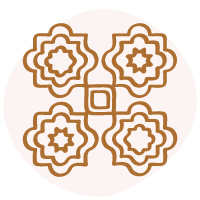
The soft colors, the sweet scent of orange blossoms, and the incredible monuments that await around every corner – these are the things that attract travelers every year to the narrow streets of Barrio Santa Cruz.
The former Jewish Quarter of Seville is undoubtedly a destination that should not be overlooked in the cultural heart of southern Spain. However, just exploring its many tapas and flamenco bars would mean overlooking its hidden gems.
This is where you can find out about the Jewish Quarter of Seville, its neighborhoods, and its best-kept secrets. Come along!
key takeaways
- The Barrio de Santa Cruz and the Barrio de San Bartolomé form togethet the Old Jewish Quarter of Seville.
- The Barrio de Santa Cruz is a neighbourhood known for being a maze of narrow colorful streets and alleys.
- Beside the Jewish Quarter of Seville, the ancient synagogue of Seville is the city’s prime Jewish landmark.

Get on a 1.5-hour walking tour to discover the Jewish heritage of Andalucia and Seville
Jump to
History of the Jewish Quarter of Seville
Santa Cruz is one of the neighborhoods in Seville with the richest history. It was first settled during Roman times when Spain was known as Híspalis. However, Barrio Santa Cruz didn’t see much development until the arrival of the Muslims.
In 1248, King Ferdinand III of Castile took back the city from the Muslims, and the Jews were made to stay in the neighborhoods of Santa Cruz and San Bartolomé. The Jewish community of Seville was then the second largest in Spain, only after that of Toledo.
They remained there until 1492, when the Jews were expelled from Spain. The Jewish Quarter of Seville gradually fell into disrepair over the following centuries until it was restored in the 20th century.
Besides its actual history, there are also some legends connected to this area! The story of Don Juan Tenorio is set in Santa Cruz. Taking place in the 16th century, the story speaks of a love that blossomed inside the labyrinth of the Casco Antiguo (the old town of Seville).
You can imagine that not everything standing today was there when the Jews lived in Santa Cruz. Interestingly, the churches of San Bartolomé, Santa María la Blanca (in the San Bartolomé neighborhood), and Santa Cruz (now the Plaza de Santa Cruz) were built on the locations of synagogues, which themselves were constructed on former mosques.
The neighborhood took its name from the church of Santa Cruz. The term “Santa Cruz” itself translates to “Holy Cross” in English.

Interested in Jewish history? Here’s a Private Tour of Seville that is all about Sephardic History
Barrio de Santa Cruz
Where is the Barrio de Santa Cruz?
Santa Cruz is a part of the Casco Antiguo area in Seville. It’s situated to the south of El Arenal and Alfalfa, and to the north of the Parque de María Luisa.
But what does this mean in words that are easier for travelers to understand?
If you’re walking around the streets between the Plaza de España, the Torre del Oro, and Las Setas, you’re actually in the Santa Cruz neighborhood. (Unless you happen to be in the San Bartolomé neighborhood, which we’ll explore later. These two together make up the Jewish quarter of Seville!)
The Barrio Santa Cruz consists of the lovely streets around the Cathedral of Seville.
Best things to see in the Barrio Santa Cruz
- Real Alcázar de Sevilla: The royal palaces need no introduction. It’s probably one of the reasons you’re coming to Seville. I’ve written a whole post about how to visit the Real Alcázar just for you.
- Cathedral and the Giralda: Also one of the best attractions of Seville. The world’s largest Gothic building is the resting place of Christopher Columbus’ tomb. The Giralda, the cathedral’s bell tower, is a symbol of the city’s great past, and one of the best places to visit in Seville for the views.
- Hospital los Venerables: Once a retreat for older priests, it now brings together a mansion and a lovely small church to create a museum. This museum displays some wonderful and thoughtfully chosen artworks.
- Calle Mateos Gago : Nowadays, this is among the most classic streets in Santa Cruz, brimming with tapas bars and eateries. (More on that below.)
- Plaza del Triunfo: Around it, you’ll find some of the city’s major highlights: the Alcazar de Sevilla, the Seville Cathedral, and the Archivo de Indias.
- Patio de Banderas: A great place for pictures in Santa Cruz, and surely one of the best. If you’ve come across a snapshot of a charming Andalusian square with the Giralda towering in the backdrop, this is the place. Lined with trees and reachable through an arch, it’s no surprise why.
Hidden gems in the Barrio de Santa Cruz
Best plazas and squares in Santa Cruz
- Plaza de los Venerables: Lots of tourists come to this small square, and it can get really quite busy during the day. People come here to see the old Hospital de los Venerables and look at the craft shops. There are also terraces to sit and small restaurants where you can try the famous Sevillian tapas.
- Plaza de Santa Cruz: Patios conquered by hundreds of flowers, ancestral houses, winding streets, and the roots of tradition… The most famous and prettiest square in Seville is the Plaza de Santa Cruz. just a few steps away from the Cathedral, the buildings surrounding the Plaza de Santa Cruz are exemplars of the traditional aesthetics of Sevillian architecture. The Santa Cruz Church used to be at the Plaza de Santa Cruz a long time ago. But in 1811, the French destroyed it and the church was moved to where it is now, in the old church of Clérigos Regulares Menores del Espíritu Santo.
- Plaza de Doña Elvira: Don Juan is back! If you don’t know much about Zorrilla’s work, it might not hold the same importance for you. (A famous legend of the city says this was where Don Gonzalo de Ulloa, Doña Elvira’s dad, lived.) But still, lots of tourists visit this square because it’s so pretty. It is part of the usual sightseeing route in the Barrio de Santa Cruz.
- Plaza de la Alianza: Right next to the Real Alcazar of Seville, this square is always full of tourists. But from here, you can see the beautiful La Giralda tower really well.
Calle de las Cruces
It’s one of the quiet spots in the Santa Cruz neighborhood that’s known for its charming and simple beauty. The square stands out with three crosses at its center. Calle de las Cruces might not be the most popular place for tourists, but it is wonderful small and hidden square.
It’s a overall great spot to experience the heart of the Barrio Santa Cruz.
Synagogues in the Jewish Quarter of Seville?
The Iglesia de Santa María la Blanca was built in the 13th century as a synagogue. This Baroque-style church has paintings by the famous Spanish painter Murillo inside – he’s the same man the Murillo gardens are named after. The most surprising and magnificent part is the interior, with artwork carved on the ceiling and arches, along with murals that mirror them. However, there are no remaining features from the days when it was used as a synagogue or mosque.
Barrio de San Bartolomé
Where is the Barrio de San Bartolomé?
San Bartolomé is undoubtedly “the forgotten neighborhood of Seville.” It was originally part of La Judería, just like the more famous Santa Cruz neighborhood.
Even though it doesn’t have many monuments, it’s a charming area that’s definitely worth a few hours of exploration.
The San Bartolomé neighborhood is located just north of the Santa Cruz neighborhood and east of the Alfalfa neighborhood (where you’ll find Las Setas).
Casa de Pilatos
Seville boasts a few palaces finer than this one. Dating back to the 15th and 16th centuries, many believe that Casa de Pilatos was modeled after Pilate’s house in Jerusalem. The design follows the typical Andalusian style, featuring a central patio decorated with colorful ceramic tiles and ancient sculptures.
Pssst! The Casa de Pilatos is one of the most beautiful wedding venues in Seville.
Getting to the Jewish District
The Jewish Quarter is located in the heart of the historic center of Seville. Exploring these neighborhoods is undoubtedly best done on foot.
If you’re arriving by car, the best places to park in the Santa Cruz area are Parking Cano y Cueto and Parking Paseo Colon.
Guided tour of the Jewish Quarter of Seville
This post is a great overview of the old Jewish quarter of Seville, but nothing beats having a real guide when you’re there.
Feel the City Tours is a company based in Seville, and their guides offer excellent and affordable tours of the city.
Is the Santa Cruz neighborhood in Seville dangerous at night?
There are many cafes and restaurants open late into the evening in Barrio Santa Cruz, and many theatergoers visit these places after the show. In the old Jewish quarter of Seville, you won’t find any empty or quiet streets. The streets are well-lit, and there are people out walking and dining even late at night. It’s usually safe to walk around the Barrio Santa Cruz after 11 pm.
Where to stay in the Barrio de Santa Cruz
Santa Cruz is my favorite place to stay in Seville! In fact, it’s the perfect area for most travelers.
If it’s your first time in town? It’s the prettiest neighborhood of Seville! If you’re here for a short stay? It’s close to all major attractions. You’ve chosen Seville as your base to explore the region? Santa Justa Train Station is really close to Santa Cruz!
| TYPE | ACCOMMODATION | PRICE |
| Mid-range | Joya del Casco Boutique Hotel | From € 141 / night |
| Luxury | EME Catedral Mercer Hotel | From € 227 / night |
| Luxury | Boutique Hotel Casa del Poeta | From € 256 / night |
| Budget | Lukanda Hospec | From € 85 / night |
Where to eat in the Barrio de Santa Cruz
In the streets of the Judería, there are really good places to have a romantic lunch or dinner, or to try the famous Sevillian tapas.
You’ll see that the Jewish quarter has lots of bars and restaurants, from fancy ones to local spots that have been around for generations.
If you want to just go with the flow, you can start looking for your new favorite place by walking down Calle Mateos Gago (near the Cathedral of Seville). This trendy street is brimming with tapas bars and it takes you to the center of the Santa Cruz neighborhood. Sevillians say you should try tapas at each bar as you go down the street!

Seville Food Sherpas are the best and you can’t convince me otherwise. Tapas can be bought, but traditions can only be shared. Thank me later 😉
If you want some suggestions, here’s a list of the best restaurants to enjoy Andalusian cuisine in the neighborhood:
- Bodega Santa Cruz (Google Maps) – Tapas bar
- Pelayo Tapas Bar (Google Maps) – Tapas bar
- Restaurante San Marco Santa Cruz (Google Maps) – Mediterranean restaurant
- El Pasaje (Google Maps) – Tapas restaurant
- La Azotea Vinos & Tapas (Google Maps) – Mediterranean restaurant
- Restaurante El 3 de Oro (Google Maps) – Andalusian restaurant
Read more
Where to Stay · Where to Stay in Seville · Seville vs Granada
Seville Travel Guide · Best Tours · Rooftop Tour of Seville Cathedral · Orange Blossoms in Seville · Inside the Real Alcazar
Itineraries · How to Spend 2 or 3 days in Seville
Parking in Seville · Parking in Seville (In Under 15 Minutes)
Day Trips · Córdoba · Tangier · Jerez · Cádiz · Granada












